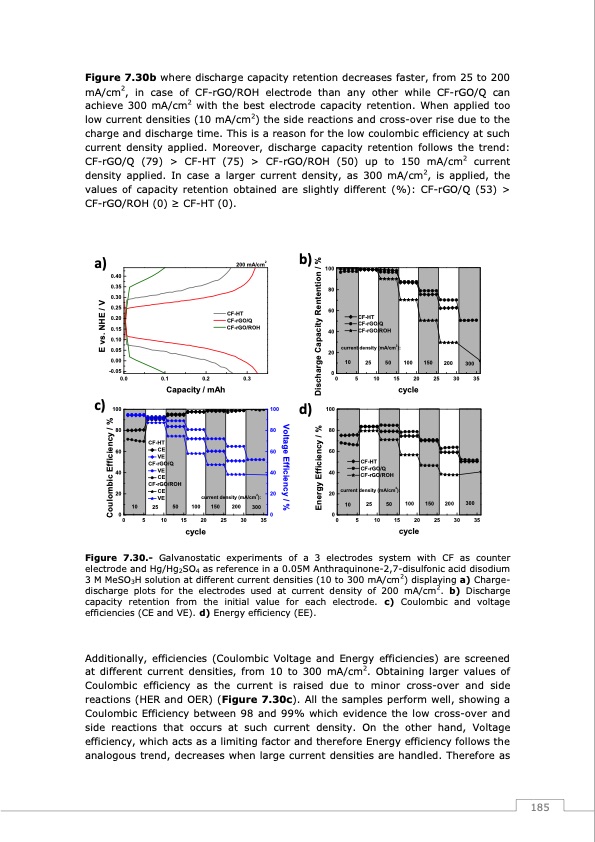
PDF Publication Title:
Text from PDF Page: 186
Figure 7.30b where discharge capacity retention decreases faster, from 25 to 200 mA/cm2, in case of CF-rGO/ROH electrode than any other while CF-rGO/Q can achieve 300 mA/cm2 with the best electrode capacity retention. When applied too low current densities (10 mA/cm2) the side reactions and cross-over rise due to the charge and discharge time. This is a reason for the low coulombic efficiency at such current density applied. Moreover, discharge capacity retention follows the trend: CF-rGO/Q (79) > CF-HT (75) > CF-rGO/ROH (50) up to 150 mA/cm2 current density applied. In case a larger current density, as 300 mA/cm2, is applied, the values of capacity retention obtained are slightly different (%): CF-rGO/Q (53) > CF-rGO/ROH (0) ≥ CF-HT (0). a) 0.40 0.35 0.30 0.25 0.20 0.15 0.10 0.05 0.00 -0.05 0.0 0.1 0.2 200 mA/cm2 0.3 b) 100 80 60 40 20 0 0 5 10 15 20 25 30 35 cycle 0 5 10 15 20 25 30 35 cycle CF-HT CF-rGO/Q CF-rGO/ROH current density (mA/cm2): 10 25 50 100 150 200 300 CF-HT CF-rGO/Q CF-rGO/ROH c) 100 80 60 40 20 100 d) 100 Capacity / mAh CF-HT CF-rGO/Q CF-rGO/ROH current density (mA/cm2): 10 25 50 100 150 200 300 10 CF-HT CE VE CF-rGO/Q VE CE CF-rGO/ROH CE VE 25 50 current de 100 150 nsity (mA/cm2): 200 300 000 0 5 10 15 20 25 30 35 cycle 8080 6060 4040 2020 Figure 7.30.- Galvanostatic experiments of a 3 electrodes system with CF as counter electrode and Hg/Hg2SO4 as reference in a 0.05M Anthraquinone-2,7-disulfonic acid disodium 3 M MeSO3H solution at different current densities (10 to 300 mA/cm2) displaying a) Charge- discharge plots for the electrodes used at current density of 200 mA/cm2. b) Discharge capacity retention from the initial value for each electrode. c) Coulombic and voltage efficiencies (CE and VE). d) Energy efficiency (EE). Additionally, efficiencies (Coulombic Voltage and Energy efficiencies) are screened at different current densities, from 10 to 300 mA/cm2. Obtaining larger values of Coulombic efficiency as the current is raised due to minor cross-over and side reactions (HER and OER) (Figure 7.30c). All the samples perform well, showing a Coulombic Efficiency between 98 and 99% which evidence the low cross-over and side reactions that occurs at such current density. On the other hand, Voltage efficiency, which acts as a limiting factor and therefore Energy efficiency follows the analogous trend, decreases when large current densities are handled. Therefore as 185 Voltage Efficiency / % Coulombic Efficiency / % E vs. NHE / V Energy Efficiency / % Discharge Capacity Rentention / %PDF Image | Redox Flow Batteries Vanadium to Earth Quinones

PDF Search Title:
Redox Flow Batteries Vanadium to Earth QuinonesOriginal File Name Searched:
FJVG_TESIS.pdfDIY PDF Search: Google It | Yahoo | Bing
Salgenx Redox Flow Battery Technology: Salt water flow battery technology with low cost and great energy density that can be used for power storage and thermal storage. Let us de-risk your production using our license. Our aqueous flow battery is less cost than Tesla Megapack and available faster. Redox flow battery. No membrane needed like with Vanadium, or Bromine. Salgenx flow battery
| CONTACT TEL: 608-238-6001 Email: greg@salgenx.com | RSS | AMP |